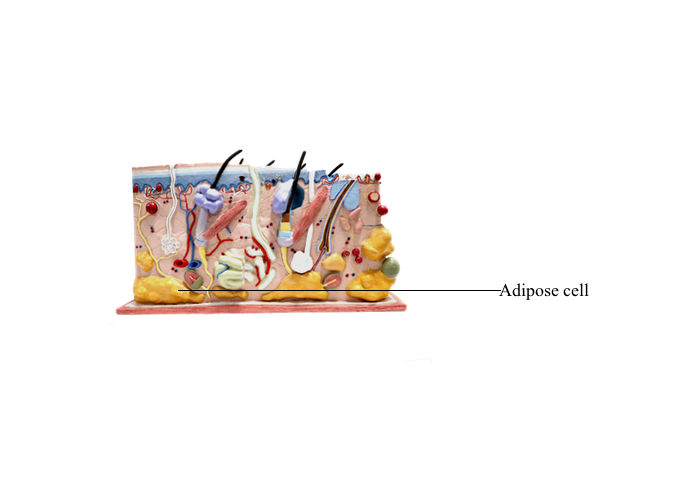Main Model

Anterior : Adipose cell

Adipose Tissue or Fat
There are two classes of adipose tissue:
1. White fat, the major reserve of long-term
energy and also an endocrine tissue
2. Brown fat, which participates in thermogenesis
Similar to fibroblasts, chondroblasts, osteoblasts
and myoblasts, white fat and brown fat adipose cells
derive from a mesenchymal stem cells in a process
known as adipogenesis.
White Adipose Tissue
Adipose tissue is the storage center for fat. White (unilocular) adipose tissue consists
of densely packed adipose cells. Each adipose cell contains a single large drop of fat
(hence the "unilocular" name). The fat is dissolved out by alcohol during the preparation procedure, leaving a large vacuole. The adipose cell has a flattened nucleus
and sheetlike cytoplasm, which has been pushed into a rim surrounding the fat
drop. Between adipose cells there are capillaries and a very small amount of connective tissue with reticular fibers, which can be demonstrated by silver
impregnation. In this tissue type, adipose cells are usually separated into lobules by
a connective tissue septum containing blood vessels and nerve fibers.
Under the influence of the hormone insulin, the adipose cells can synthesize fat
from fatty acids or carbohydrate. The vital balance between deposits and withdrawals of the fat is affected by hormones and by the autonomic nervous system.
Except for the eyelid, penis, and scrotum, adipose tissue is present throughout the
body, and is especially abundant in the hypodermis, mesenteries, omenta, and
around the kidneys. The white adipose tissue, which constitutes as much as 20% of
total body weight in a normal male adult and up to 25% in female, acts as a storage site and metabolic source of neutral fat, a cushion against mechanical shock,
and a insulator to prevent excessive heat loss or gain through the skin.
Brown Adipose Tissue
Brown (multilocular) adipose tissue differs from white adipose tissue by both the
organization of its lipid and its characteristic color. Brown adipose tissue is abundant in hibernating mammals. In human beings, it is common in the fetus, but
almost absent in the adult. Brown adipose tissue is distributed mainly in the shoulder girdle and some other areas. It is composed of densely packed brown adipose
cells. The cytoplasm contains a number of lipid droplets of various sizes; thus, this
tissue type is also called multilocular adipose tissue. In addition, abundant in the
cytoplasm are the mitochondria and lysosomes, which give the tissue its brown color. The nucleus of the multilocular adipose cell is spherical, located centrally or
eccentrically. Between the adipose cells is a rich supply of capillaries. In hibernating
animals and the human fetus, the brown adipose tissue generates heat to keep the
body warm during cold temperatures.